Resource Indexing and Querying in Large Connected Environments
Abstract
:1. Introduction
2. Motivating Scenario
2.1. Connected Environment Setup
2.1.1. Environment Description
- When a supervisor (user 1 in Figure 1) would like to know the temperature of a zone, she/he draws visually on the monitoring PC the zone to be requested. The PC sends the request (Q1) to the zone’s head (D1) located in or near the targeted zone. The respective device will return a response with the temperature of the zone.
- Another agent (user 2 in Figure 1) wants to gather the temperature of another zone (Z5). He draws visually on the monitoring PC the requested zone, and the query is forwarded to the nearest device. If the device knows from its own index that the requested zone (Z5) is uncovered, it can return an immediate response without further forwards of the request, consequently avoiding the usage of other devices’ capacities.
- Another interesting case is when a firefighter (user 3 in Figure 1) is trying to put out a fire but does not know its exact location inside a large and dense forest, in which fire can spread rapidly. The firefighter seeks to take out affected regions by activating the fire suppression system to extinguish the fire before it can progress further into the forest. He must predict the fire progression to activate the system in specific areas instead of activating it in the entire forest. The request is based on exceeding a certain threshold, indicating that a fire is probable. In the forest, he/she needs to urgently broadcast a request in order to quickly retrieve the fire’s location. After broadcasting the request, one or several devices will be aware if a fire is detected within their zones (e.g., zone 3). The response is sent back by at least one of those devices.
2.1.2. Device Properties
2.1.3. Data Retrieval
2.2. Needs & Challenges
- Need 1—Query types: users need to detect events, while considering different urgency levels (e.g., a wildfire is more urgent than requesting information for data analytics) in their queries;
- Need 2—Device capacity-based querying: users needs to send their queries to optimal (indexed) devices in a way that reduces network usage and provides the best possible response;
- Need 3—Location-based querying: users need to issue a query from any place in the environment. They also need to retrieve data from a specified area/zone (e.g., obtain temperature data from the left side of the forest), from an unspecified area/zone, i.e., based on a target objective (e.g., obtain alarming high-temperature readings), or based on a combination of both (e.g., obtain alarming high temperature readings from the left side of the forest).
- Challenge 1: How to consider the capacity of the devices in each index, in order to optimize network lifecycle and querying?
- Challenge 2: How to maximize the index’s coverage by considering covered and uncovered zones?
- Challenge 3: How to adapt the indexing scheme to the different types of queries?
3. Related Work
3.1. Indexing Overview
3.2. Indexing Approaches
3.3. Summary Table
- One-path queries use a single path to reach the device, without considering whether the query will return a response. One-path queries have the lowest priority but consume the least amount of resources;
- Retry queries have moderate priority. If no response is returned, there is a probability of finding another path to reach the target destination (e.g., trying to avoid missing data while gathering data). When a blocked path is encountered, another path is searched, starting from the previous node. Since this is a moderate-priority query, multiple paths may be tested, but not all of them, to reduce energy consumption;
- Guaranteed queries will try all possible paths to reach the destination. Consequently, the system will undoubtedly generate a response (if the network allows), but this has the highest resource consumption.
4. Preliminaries & Assumptions
4.1. Spatio-Temporal Dimension
- label: is the zone label
- shape: is a geometric form describing the zone.
- L: is the set of location stamps that constitute the area of the shape (cf. Definition 2).
- format is the coordinate referential system that specifies the format of the location stamp value (e.g., default GPS, Cartesian, spherical, cylindrical)
- value is the point coordinate value (e.g., or depending on the chosen format).
- l1:
- format is a string indicating the format of the date-time value of t
- value is the timestamp value.
- t1:
4.2. Sensing Devices and Observations
- id: is the device identifier in the network (e.g., URI)
- l: is the location stamp of the device
- c: is the device’s indexing capacity (i.e., the number of index entries d is capable of storing locally)
- : is the set of sensors s embedded on d. Each sensor is defined as where
- –
- o: is an observation (i.e., sensed data) (cf. Definition 5)
- –
- cz: is its coverage zone.
- d1:
- a is the data attribute
- v is the data value
- l is the creation location stamp of o (cf. Definition 2)
- t is the creation temporal stamp of o (cf. Definition 3)
- es is the embedded sensor that produced/created o.
- o1:
4.3. Queries
- σ is a selection/projection operation
- is the set of selection expressions, where
- –
- a is the required attribute
- –
- ⨁ is an operator (e.g., <, >, ⩽, ⩾, !, =)
- –
- v is the attribute’s value
- is the query target, indicating where to select data from within the connected environment ce where
- –
- is a set of devices deployed in a location
- –
- is a set of zones
- denotes the query type:
- –
- If , the query follows a unique path following a specific function (random, highest device capacity, hash) depending on the device deployment when routing. This type of query takes the least amount of time and resources in order to be completed, since it is trying one path (like the one-path queries in Section 3)
- –
- If , the query follows a unique path following a specific function until arriving at a blocked path. Then, the query tries to find another path that may be able to return a response. A different path is searched beginning at the preceding node when a block path is encountered(A blocked path is a path where the query has reached a dead end and when further forwarding or progression is no longer possible.). To save energy, a variety of paths could be tried, but not all of them. These queries are used to send queries that return information, while taking into consideration the missing data.
- –
- If , the query tries all the possible routes to reach a destination. These types of queries broadcast the message to all known devices, in order to reach the destination at all costs (like the guaranteed queries in Section 3).
- –
- If , the query tries all the possible routes, when conditions allow, to reach a destination. Here, the query is forwarded to devices having the highest number of entries during the algorithm execution. This means that the query will not be forwarded to devices having capacities less than a minimum threshold. The default query type will be the resource-optimized query, and it is commonly referred to as the default query.
4.4. Global and Local Index
- D Devices representing the index rows.
- Z Zones representing the index columns.
- bRule represents a binary association rule that establishes a link between a designated zone and a defined set of devices. Its related algorithm follows several specific patterns according to the requirements (detailed in the upcoming sections).
- is a set of devices that are visible by the device
- is a set of covered and uncovered zones that are known by
- f is a function that associates (1) the current device to its corresponding covered zone (using the symbol ‘*’), (2) each of the other covered zones in to one accessible device in , and (3) each uncovered zone in to the symbol ☐ (allowing to be aware of the zone uncoveredness).
5. Proposed Approach
5.1. Device Indexing vs. Device Networking
5.2. Hybrid Overlay Architecture
5.3. Contribution Insights
5.4. Index Generation Algorithm
| Algorithm 1: PreProcessingGlobalMatrix() |
 |
| Algorithm 2: SetupIndex() |
 |
5.5. Local Index Generation
- One-path Queries: Figure 5 illustrates an example of one-path queries taking a random path strategy. We consider that a query from the location to is sent. The device located in receives the query. does not know any information about . In that case, the query is forwarded to a randomly chosen covered zone. In this situation, is chosen. The device located in is device , meaning that this device receives the query (step 1). The query is forwarded to , since is partially covered by only. The query is forwarded to device (step 2). has an index for leading to forwarding the query to the user, with a response that is an uncovered zone. When a blocked path is faced, a “no response” message is returned for the user by the last device reached. This type of query can be used to gather data in order to perform analytics where having missing data is not important.
- Retry Queries: Figure 6 shows the cases of retrying queries with a random strategy. In this case, the source zone is , and the destination zone is . In Figure 6, the query is first sent to , which chooses a random device from its index to forward the query. chooses, for instance, to forward it to . Since has a capacity of 1, it has no information about any zone except its current zone. As a result, it is no longer possible for to continue forwarding the query, indicating that the path is blocked (even though the device has an index for its gateway, the query is not forwarded to the gateway, since the query is designated for the current sub-environment). Consequently, the query is returned to , trying to find another path. The query is re-sent to . After receives the query, it forwards it to . returns an uncovered zone response to the user. When a blocked path is faced and no more devices are in the current coverage zone, a “no-response” message is returned to the user. The following queries are used for model training, reducing missing data and making the preprocessing easier.
- Guaranteed queries: Figure 7 presents an example of a guaranteed query. is the source zone and is the destination zone. sends a broadcast request to and . is a blocked path, so the query ends here for the first path. For the second path, the query continues until reaching , having information about . If there is no path that leads to the requested destination, a no-response message is returned. These queries are for high-urgency cases such as fires and natural disasters.
- Default queries: Figure 8 demonstrates an example of a default query. Recall that guaranteed and default queries work in almost the same way, since the default queries have extra parameters (in our case, we consider a minimum capacity equal or greater to 2). The same source/destination zones are used ( to ). Once receives the query, it broadcasts it to all its index entries that fit the criteria selected. The same process is repeated until the desired destination zone is reached. Notice that the query is not routed to , due to its limited capacity, which is insufficient for accommodating a value greater than two. In this example, returns the result (uncovered zone) for the user. A no-response message is returned if no path leads to the requested destination. These queries are designed for high-urgency cases, such as fires and natural disasters, with an emphasis on minimizing the utilization of network resources.
6. Experiments
6.1. Index Generation
6.2. Index Coverage
6.3. Query Execution
6.4. Device Solicitation Experiment
6.5. Array of Things Experiments
6.6. Discussion
7. Conclusions
Author Contributions
Funding
Data Availability Statement
Acknowledgments
Conflicts of Interest
References
- Hasan, M. State of IoT 2022: Number of Connected IoT Devices Growing 18% to 14.4 Billion Globally. 2022. Available online: https://iot-analytics.com/number-connected-iot-devices/ (accessed on 29 November 2023).
- Achkouty, F.; Mansour, E.; Gallon, L.; Corral, A.; Chbeir, R. RILCE: Resource Indexing in Large Connected Environments. In New Trends in Database and Information Systems, ADBIS 2023, Proceedings of the European Conference on Advances in Databases and Information Systems, Barcelona, Spain, 4–7 September 2023; Springer: New York, NY, USA, 2023; pp. 13–22. [Google Scholar]
- Fathy, Y.; Barnaghi, P.; Tafazolli, R. Large-Scale Indexing, Discovery, and Ranking for the Internet of Things (IoT). ACM Comput. Surv. 2018, 51, 29:1–29:53. [Google Scholar] [CrossRef]
- Kamel, M.B.; Crispo, B.; Ligeti, P. A decentralized and scalable model for resource discovery in IoT network. In Proceedings of the 2019 International Conference on Wireless and Mobile Computing, Networking and Communications (WiMob), Barcelona, Spain, 21–23 October 2019; IEEE: New York, NY, USA, 2019; pp. 1–4. [Google Scholar]
- Li, Z.; Chen, R.; Liu, L.; Min, G. Dynamic resource discovery based on preference and movement pattern similarity for large-scale social internet of things. IEEE Internet Things J. 2015, 3, 581–589. [Google Scholar] [CrossRef]
- Paganelli, F.; Parlanti, D. A DHT-Based Discovery Service for the Internet of Things. J. Comput. Netw. Commun. 2012, 2012, 107041. [Google Scholar] [CrossRef]
- Cassar, G.; Barnaghi, P.M.; Moessner, K. Probabilistic Methods for Service Clustering. In Proceedings of the SMRR@ISWC Workshop, Shanghai, China, 8 November 2010. [Google Scholar]
- Wang, W.; De, S.; Cassar, G.; Moessner, K. An experimental study on geospatial indexing for sensor service discovery. Expert Syst. Appl. 2015, 42, 3528–3538. [Google Scholar] [CrossRef]
- Elmahi, M.Y.; Osman, N.; Hamza, H.S. Resource discovery classification for internet of things: A survey. Int. J. Digit. Inf. Wirel. Commun. 2020, 10, 35–50. [Google Scholar] [CrossRef]
- Ponnusamy, K.; Rajagopalan, N. Internet of things: A survey on IoT protocol standards. In Progress in Advanced Computing and Intelligent Engineering: Proceedings of ICACIE 2016, Volume 2; Springer Publishing Company, Incorporated: New York, NY, USA, 2018; pp. 651–663. [Google Scholar]
- Bormann, C.; Castellani, A.P.; Shelby, Z. Coap: An application protocol for billions of tiny internet nodes. IEEE Internet Comput. 2012, 16, 62–67. [Google Scholar] [CrossRef]
- Goland, Y.Y. Simple Service Discovery Protocol/1.0 Operating without on Arbiter. IETF INTERNET-DRAFT draft-cai-ssdp-v1-03. txt. 1999. Available online: https://link.springer.com/chapter/10.1007/978-3-540-30184-4_20 (accessed on 29 November 2023).
- Butt, T.A.; Phillips, I.; Guan, L.; Oikonomou, G. TRENDY: An adaptive and context-aware service discovery protocol for 6LoWPANs. In Proceedings of the Third International Workshop on the Web of Things, Newcastle, UK, 19 June 2012; pp. 1–6. [Google Scholar]
- Lee, K.; Kim, S.; Jeong, J.P.; Lee, S.; Kim, H.; Park, J.S. A framework for DNS naming services for Internet-of-Things devices. Future Gener. Comput. Syst. 2019, 92, 617–627. [Google Scholar] [CrossRef]
- Razzaque, M.A.; Milojevic-Jevric, M.; Palade, A.; Clarke, S. Middleware for internet of things: A survey. IEEE Internet Things J. 2015, 3, 70–95. [Google Scholar] [CrossRef]
- Cirani, S.; Davoli, L.; Ferrari, G.; Léone, R.; Medagliani, P.; Picone, M.; Veltri, L. A scalable and self-configuring architecture for service discovery in the internet of things. IEEE Internet Things J. 2014, 1, 508–521. [Google Scholar] [CrossRef]
- Djamaa, B.; Yachir, A.; Richardson, M. Hybrid CoAP-based resource discovery for the Internet of Things. J. Ambient. Intell. Humaniz. Comput. 2017, 8, 357–372. [Google Scholar] [CrossRef]
- Alam, S.; Noll, J. A semantic enhanced service proxy framework for internet of things. In Proceedings of the 2010 IEEE/ACM Int’l Conference on Green Computing and Communications & Int’l Conference on Cyber, Physical and Social Computing, Hangzhou, China, 18–20 December 2010; IEEE: New York, NY, USA, 2010; pp. 488–495. [Google Scholar]
- Chirila, S.; Lemnaru, C.; Dinsoreanu, M. Semantic-based IoT device discovery and recommendation mechanism. In Proceedings of the 2016 IEEE 12th International Conference on Intelligent Computer Communication and Processing (ICCP), Cluj-Napoca, Romania, 8–10 September 2016; IEEE: New York, NY, USA, 2016; pp. 111–116. [Google Scholar]
- Bröring, A.; Datta, S.K.; Bonnet, C. A categorization of discovery technologies for the internet of things. In Proceedings of the 6th International Conference on the Internet of Things, Stuttgart, Germany, 7–9 November 2016; pp. 131–139. [Google Scholar]
- Pozza, R.; Nati, M.; Georgoulas, S.; Gluhak, A.; Moessner, K.; Krco, S. CARD: Context-aware resource discovery for mobile Internet of Things scenarios. In Proceedings of the IEEE International Symposium on a World of Wireless, Mobile and Multimedia Networks 2014, Washington, DC, USA, 19 June 2014; IEEE: New York, NY, USA, 2014; pp. 1–10. [Google Scholar]
- Jiang, Y.; Guo, S.; Xu, S.; Qiu, X.; Meng, L. Resource discovery and share mechanism in disconnected ubiquitous stub network. In Proceedings of the NOMS 2018—2018 IEEE/IFIP Network Operations and Management Symposium, Taipei, Taiwan, 23–27 April 2018; IEEE: New York, NY, USA, 2018; pp. 1–7. [Google Scholar]
- Misra, S.; Barthwal, R.; Obaidat, M.S. Community detection in an integrated Internet of Things and social network architecture. In Proceedings of the 2012 IEEE Global Communications Conference (GLOBECOM), Anaheim, CA, USA, 3–7 December 2012; IEEE: New York, NY, USA, 2012; pp. 1647–1652. [Google Scholar]
- Ratnasamy, S.; Karp, B.; Yin, L.; Yu, F.; Estrin, D.; Govindan, R.; Shenker, S. GHT: A geographic hash table for data-centric storage. In Proceedings of the 1st ACM International Workshop on Wireless Sensor Networks and Applications, Atlanta, GA, USA, 28 September 2002; pp. 78–87. [Google Scholar]
- Greenstein, B.; Ratnasamy, S.; Shenker, S.; Govindan, R.; Estrin, D. DIFS: A distributed index for features in sensor networks. Ad Hoc Netw. 2003, 1, 333–349. [Google Scholar] [CrossRef]
- Fathy, Y.; Barnaghi, P.; Tafazolli, R. Distributed spatial indexing for the Internet of Things data management. In Proceedings of the 2017 IFIP/IEEE Symposium on Integrated Network and Service Management, Lisbon, Portugal, 8–12 May 2017; IEEE: New York, NY, USA, 2017; pp. 1246–1251. [Google Scholar]
- Fathy, Y.; Barnaghi, P.; Enshaeifar, S.; Tafazolli, R. A distributed in-network indexing mechanism for the Internet of Things. In Proceedings of the 2016 IEEE 3rd World Forum on IoT, Reston, VA, USA, 12–14 December 2016; pp. 585–590. [Google Scholar]
- Tang, J.; Xiao, Y.; Zhou, Z.; Shu, L.; Wang, Q. An energy efficient hierarchical clustering index tree for facilitating time-correlated region queries in wireless sensor network. In Proceedings of the 2013 9th Int. Wireless Communications and Mobile Computing Conference, Sardinia, Italy, 1–5 July 2013; IEEE: New York, NY, USA, 2013; pp. 1528–1533. [Google Scholar]
- Zhou, Z.; Zhou, Z.; Niu, J.; Wang, Q. EGF-tree: An energy-efficient index tree for facilitating multi-region query aggregation in the internet of things. Pers. Ubiquitous Comput. 2014, 18, 951–966. [Google Scholar] [CrossRef]
- Hoseinitabatabaei, S.A.; Fathy, Y.; Barnaghi, P.; Wang, C.; Tafazolli, R. A novel indexing method for scalable iot source lookup. IEEE Internet Things J. 2018, 5, 2037–2054. [Google Scholar] [CrossRef]
- Benrazek, A.E.; Kouahla, Z.; Farou, B.; Ferrag, M.A.; Seridi, H.; Kurulay, M. An efficient indexing for Internet of Things massive data based on cloud-fog computing. Trans. Emerg. Telecommun. Technol. 2020, 31, e3868. [Google Scholar] [CrossRef]
- Dong, C.; Jiang, L.; Wang, K. IoT Search Method for Entity Based on Advanced Density Clustering. In Proceedings of the 2020 Information Communication Technologies Conference, Nanjing, China, 29–31 May 2020; IEEE: New York, NY, USA, 2020; pp. 64–69. [Google Scholar]
- Huang, C.Y.; Chang, Y.J. An adaptively multi-attribute index framework for big IoT data. Comput. Geosci. 2021, 155, 104841. [Google Scholar] [CrossRef]
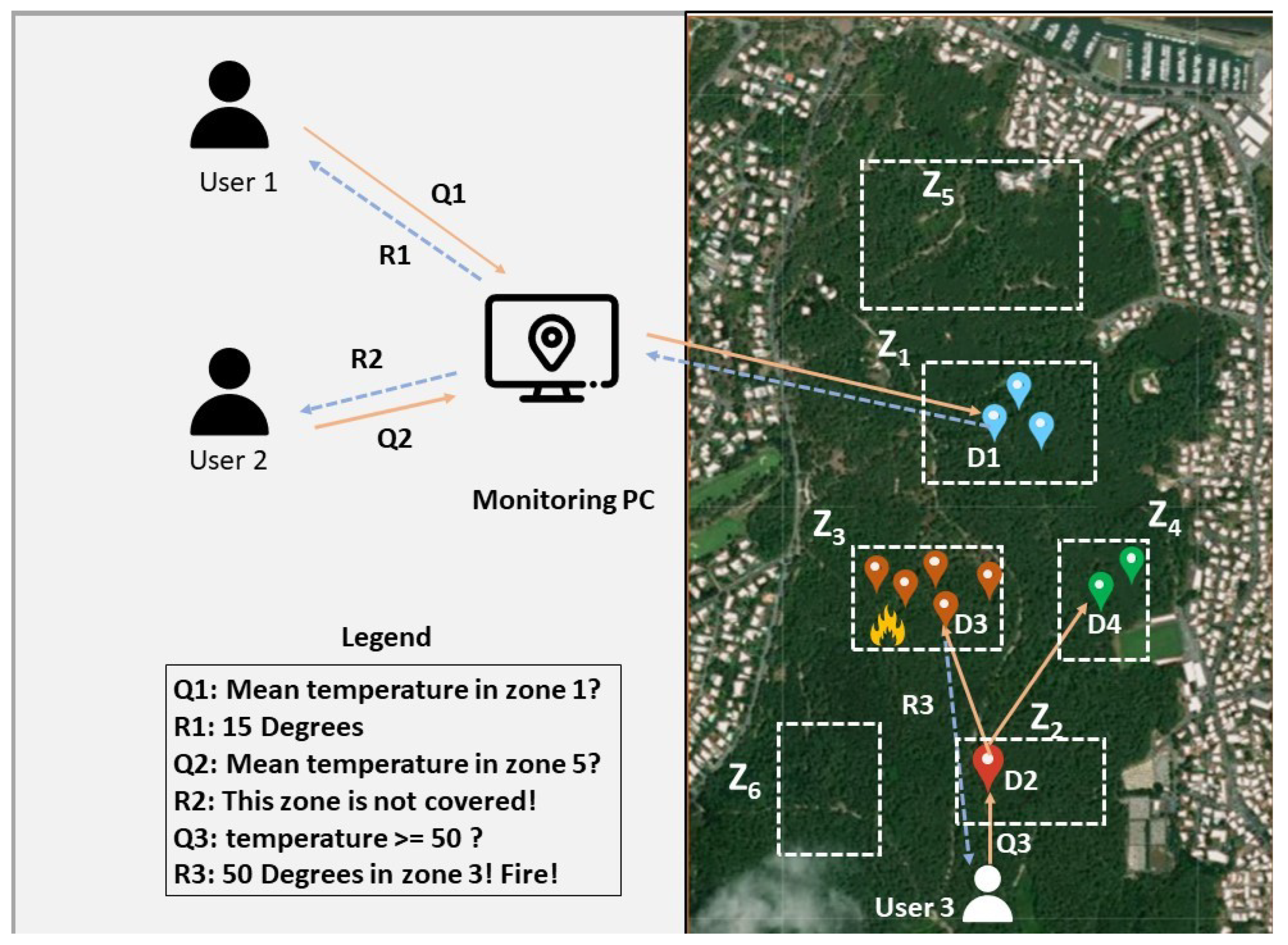

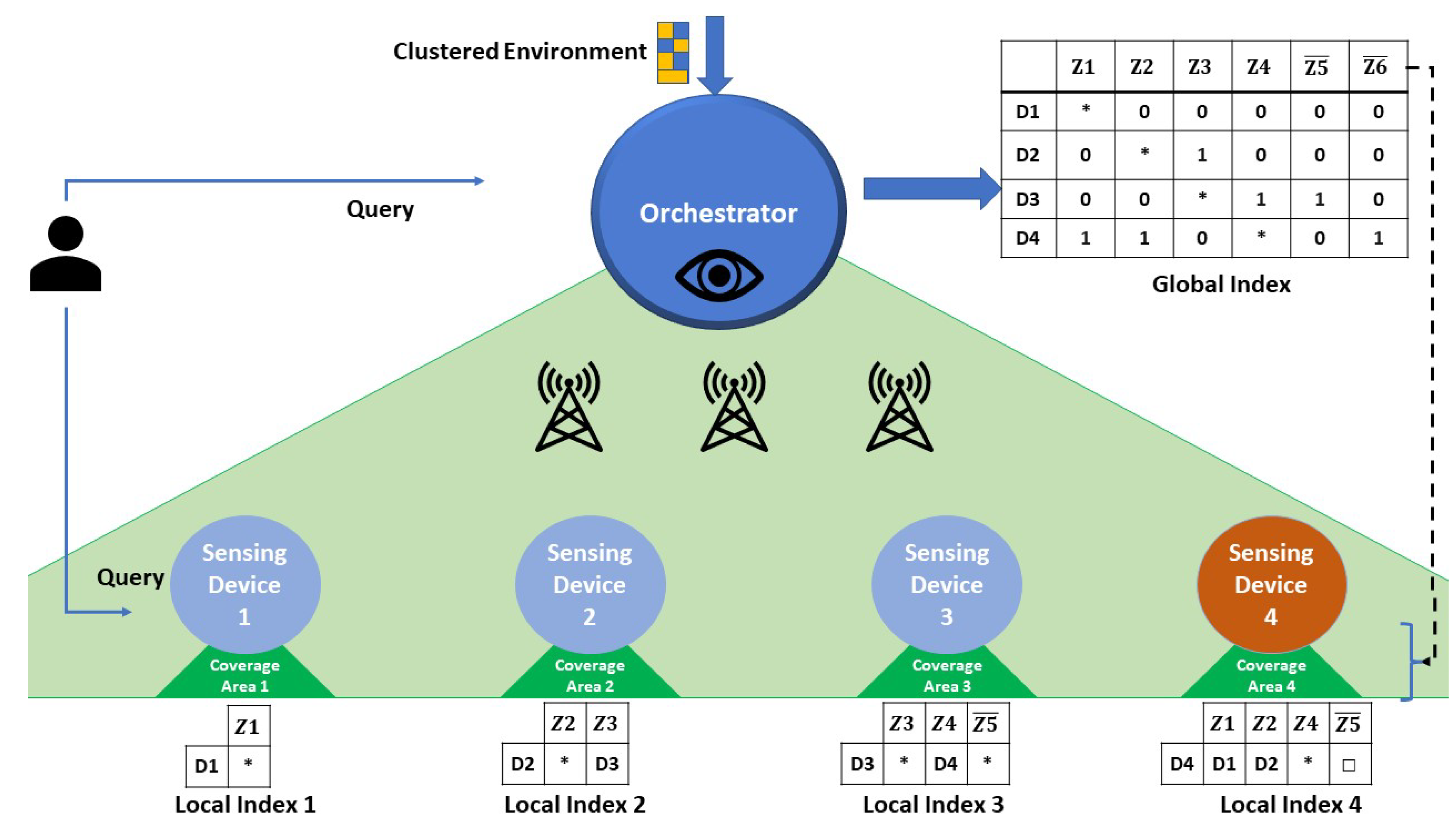

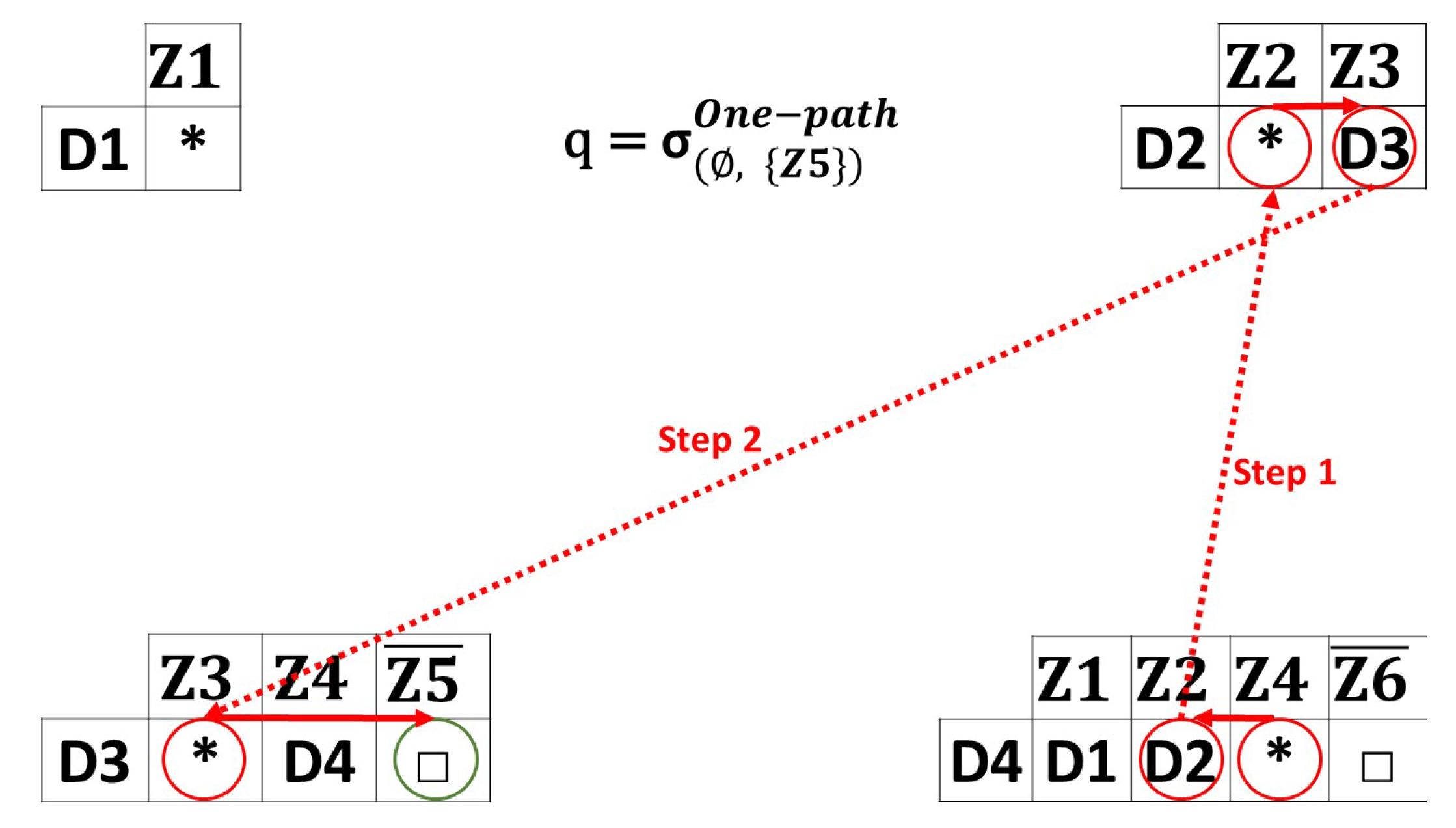
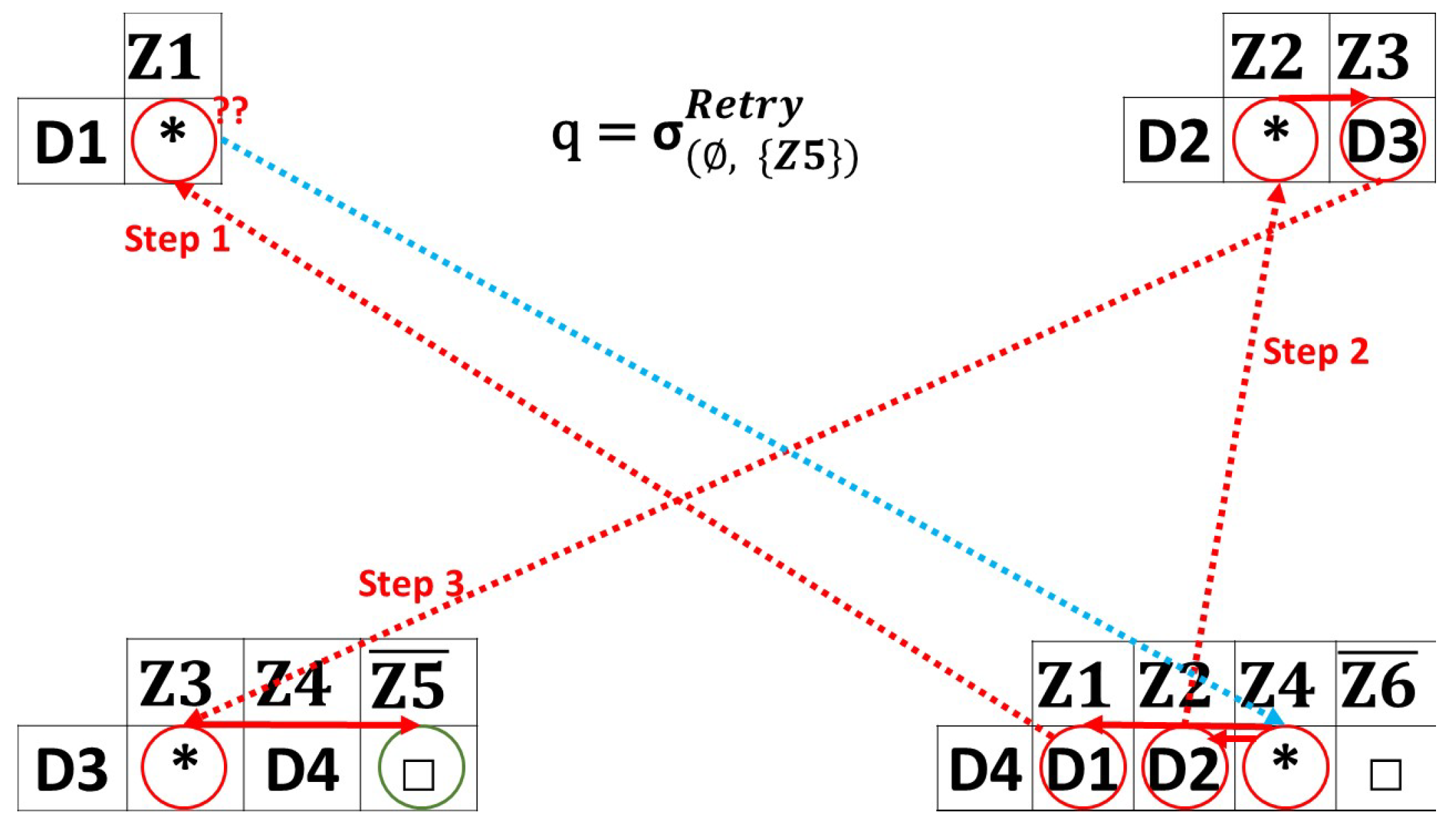
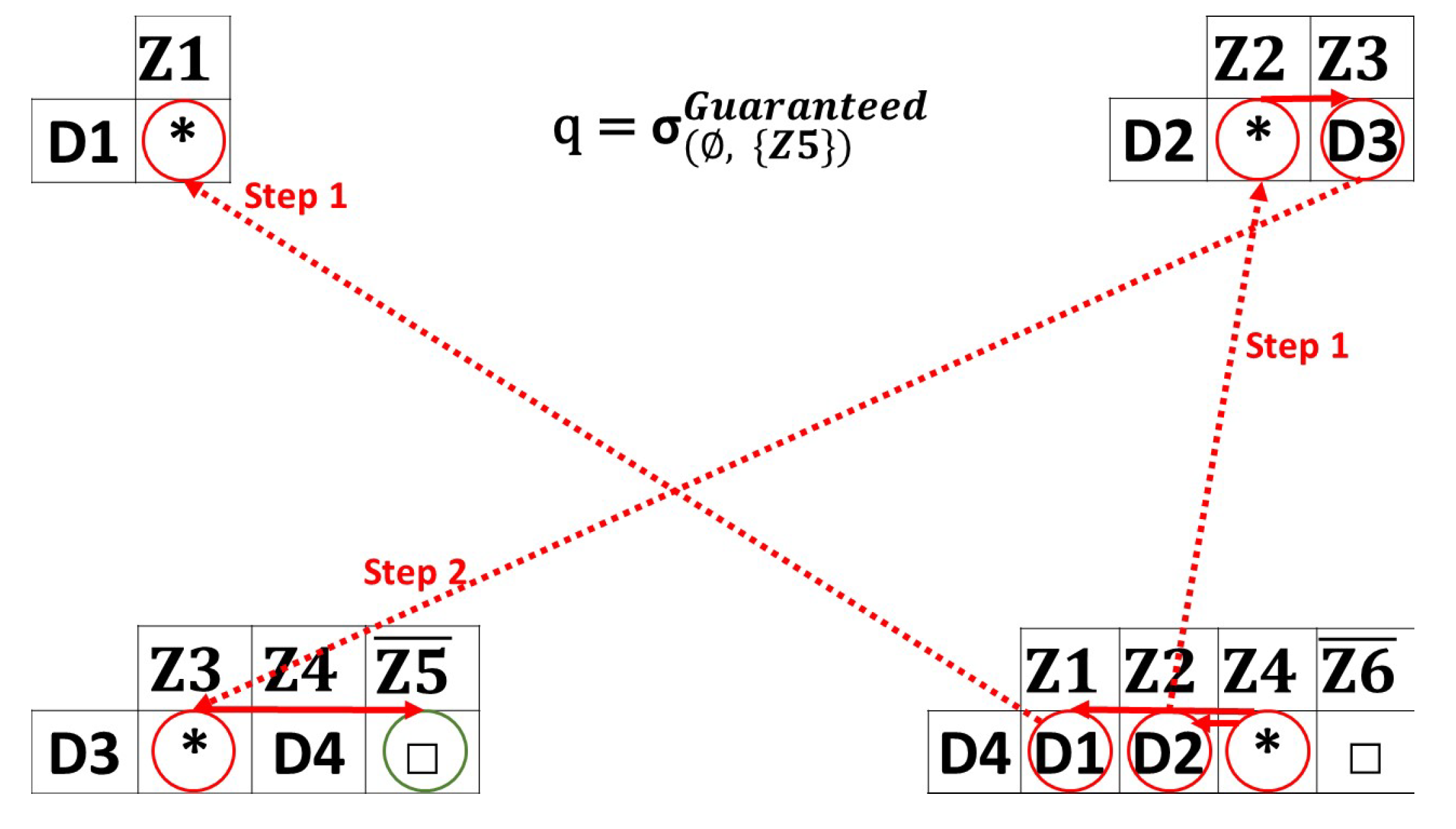
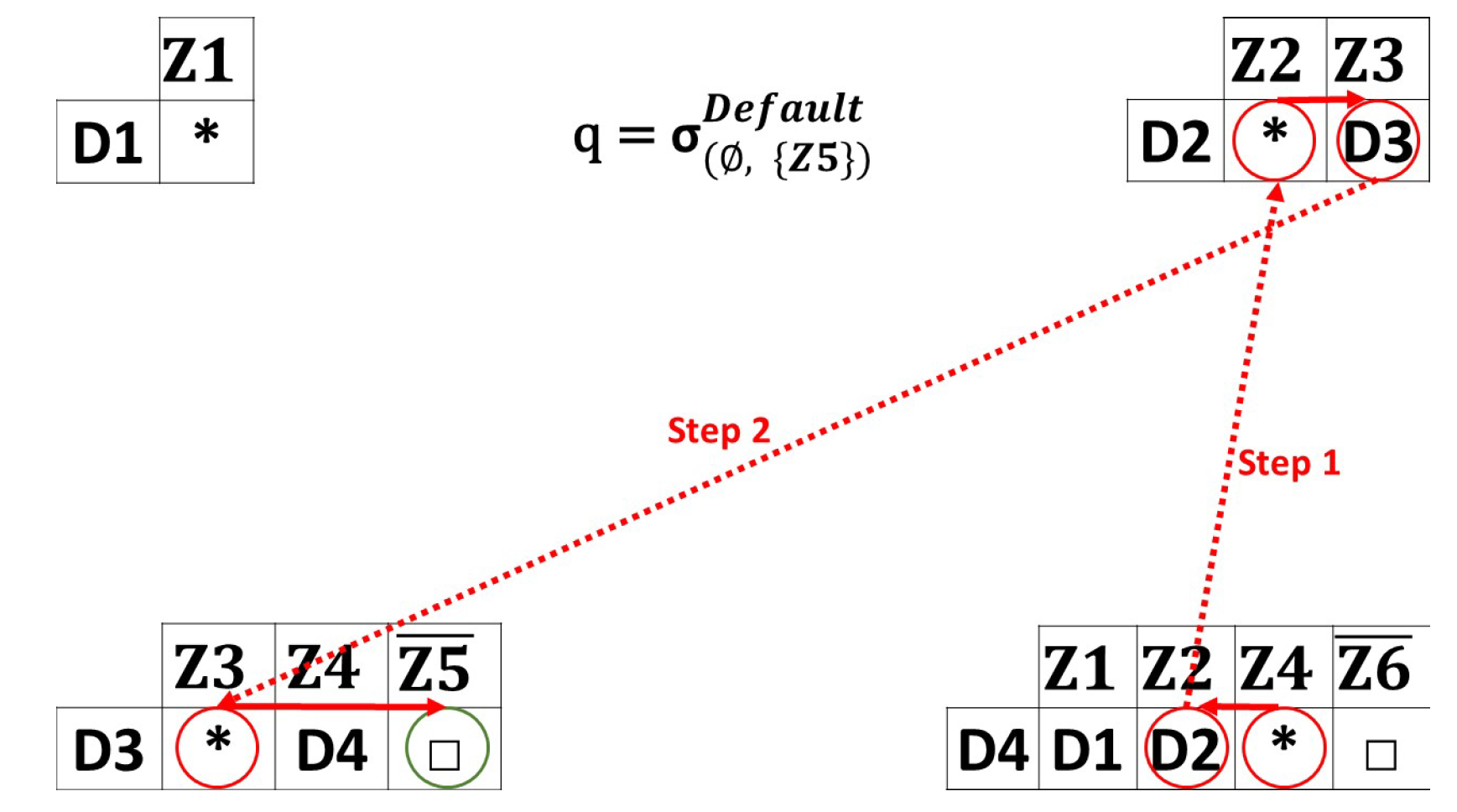

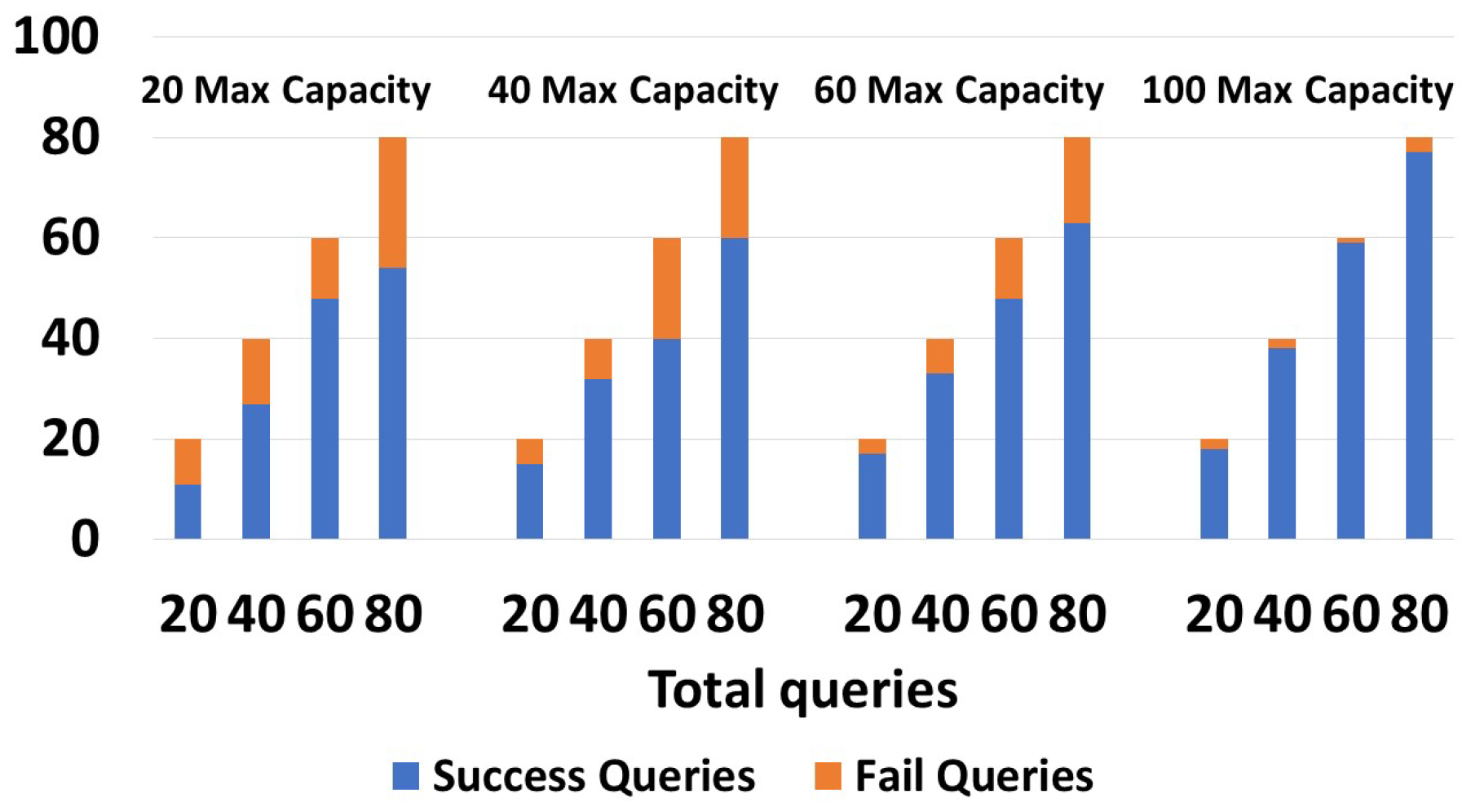
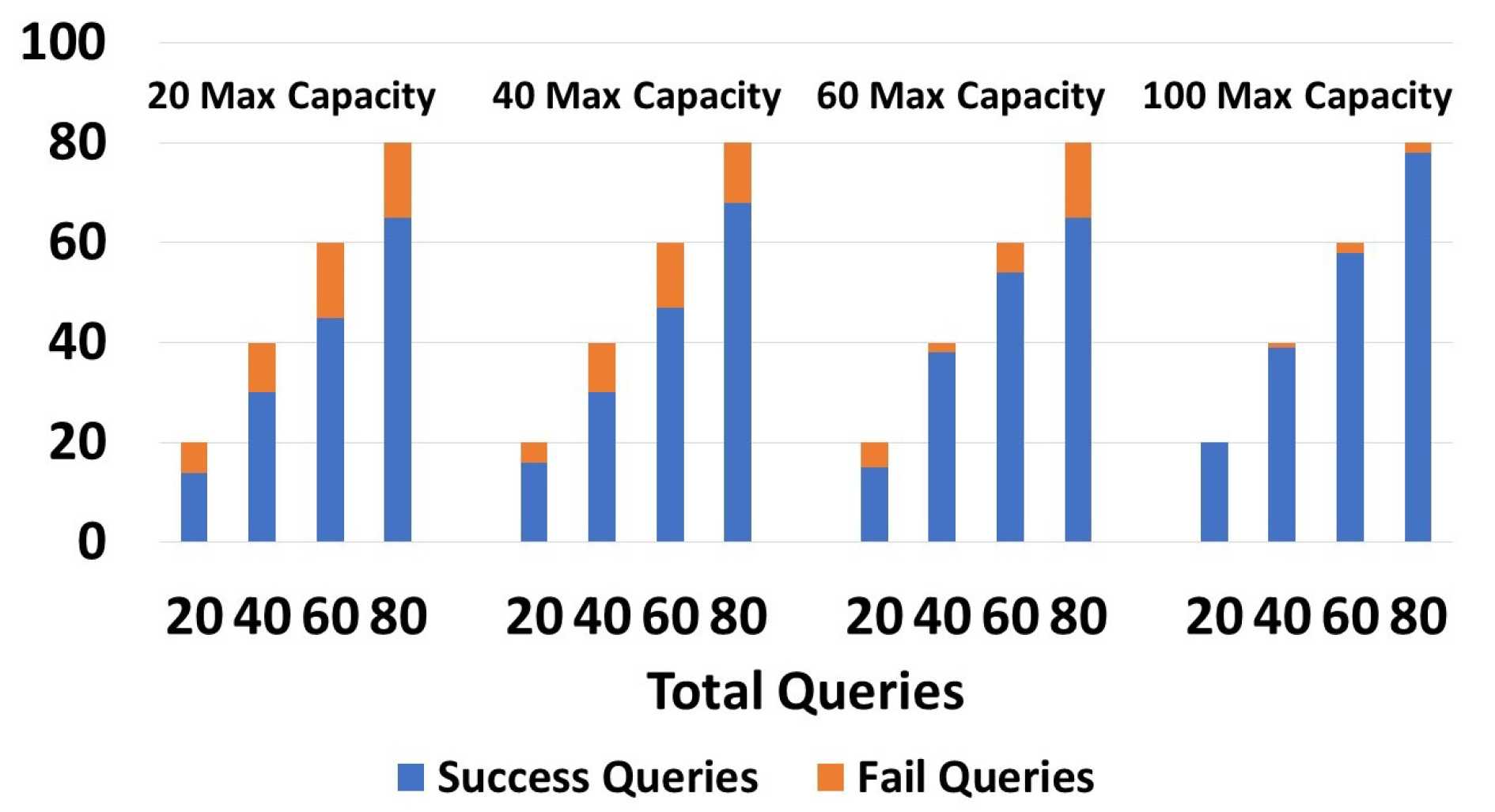
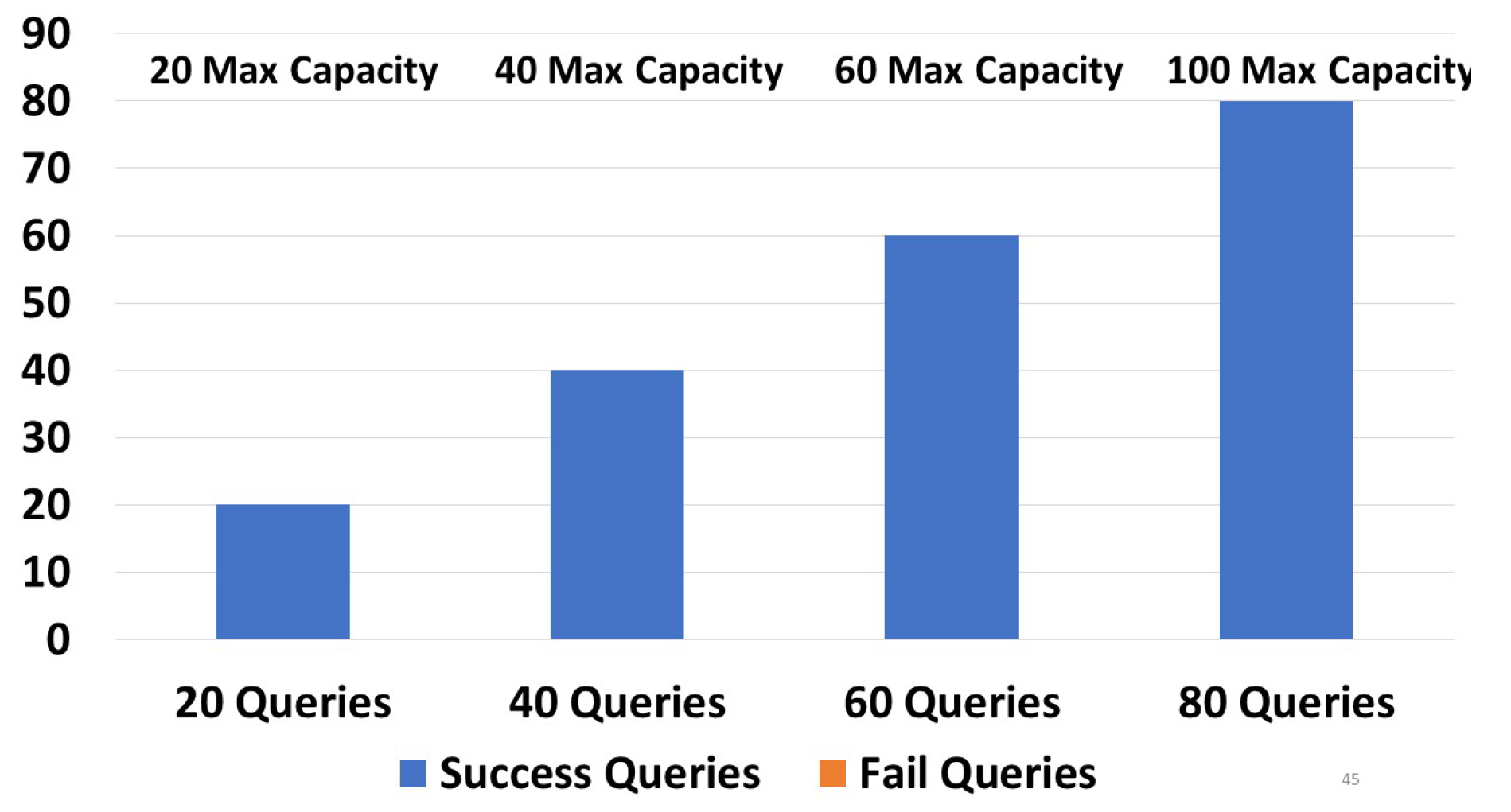
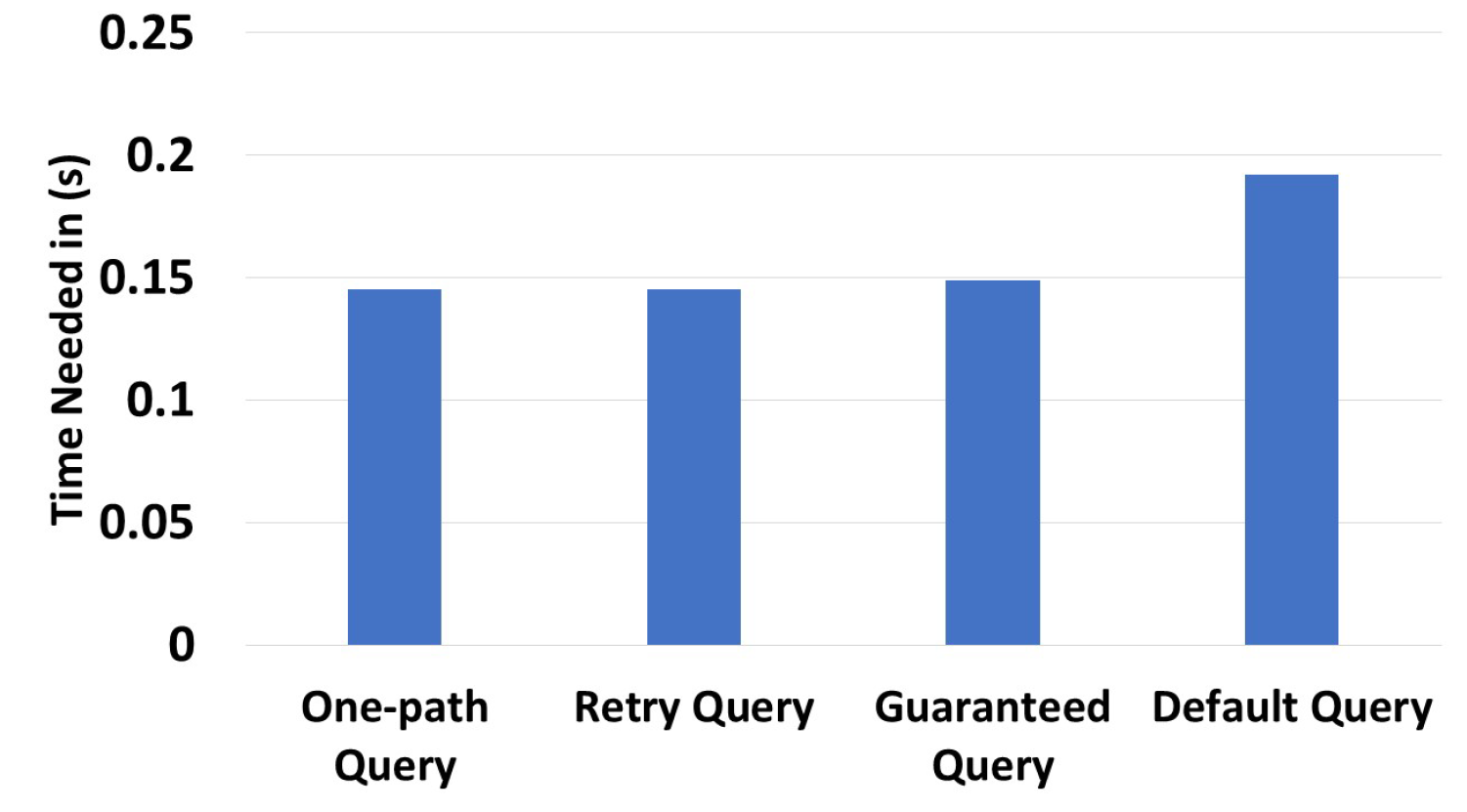
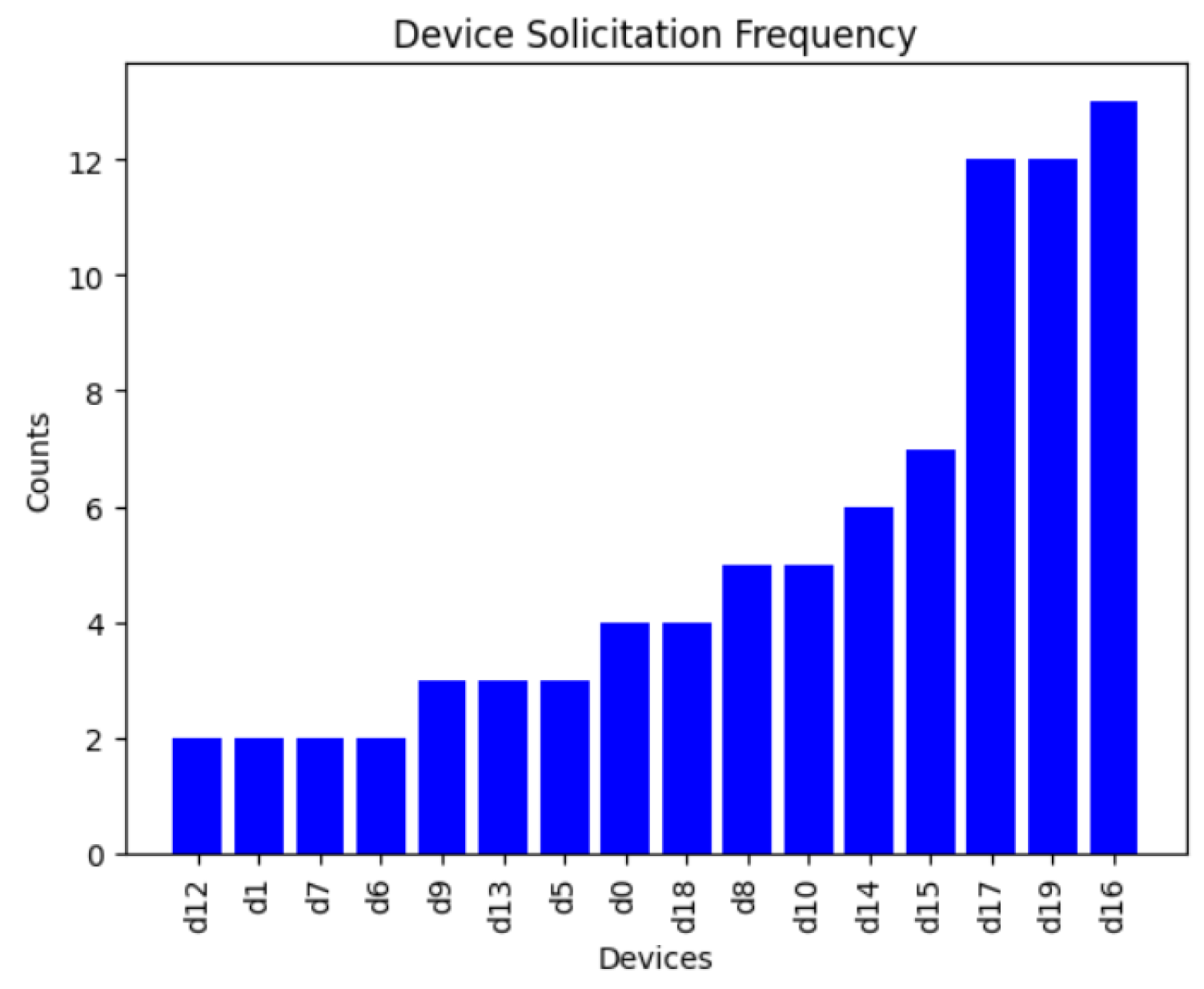

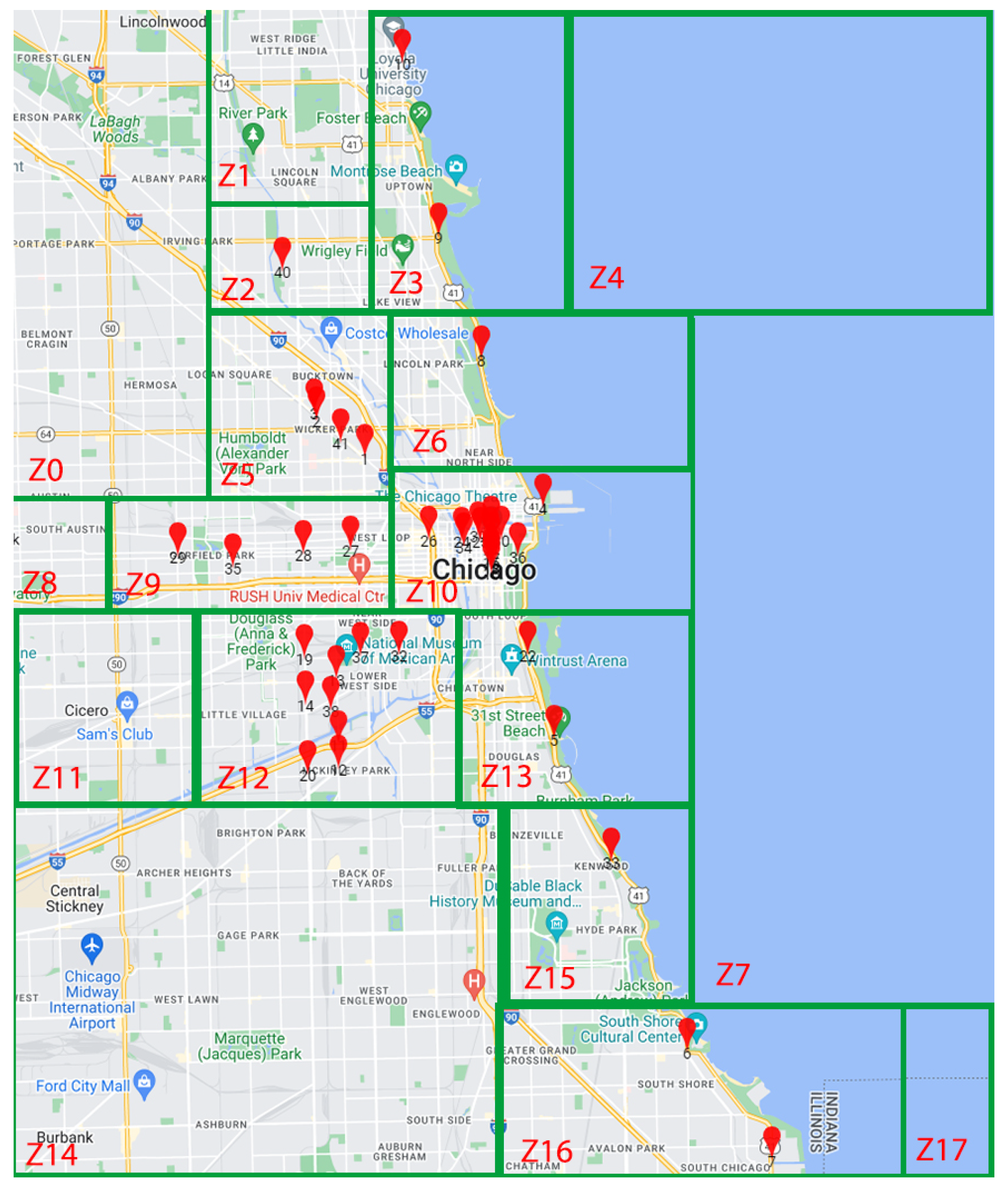
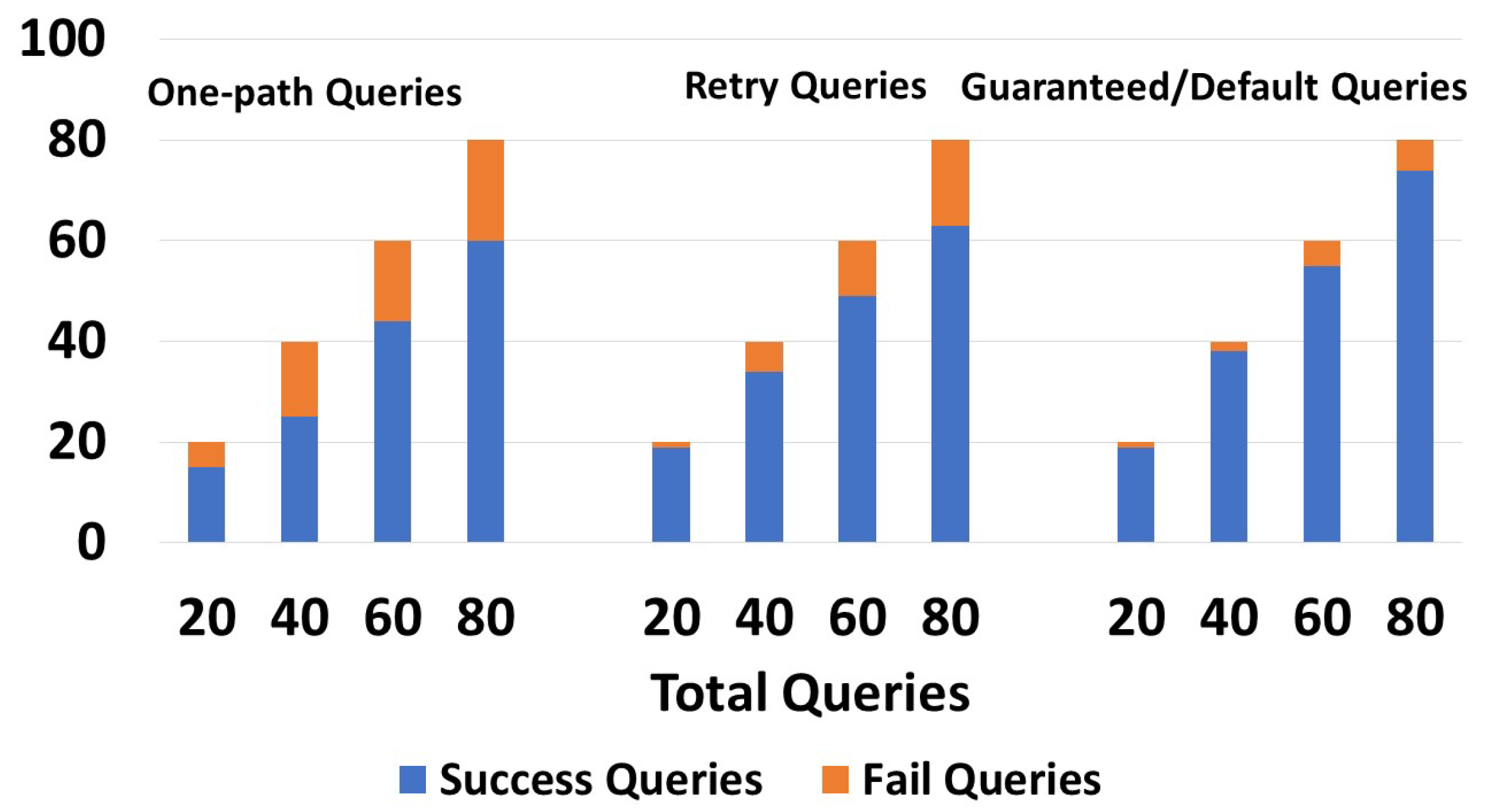
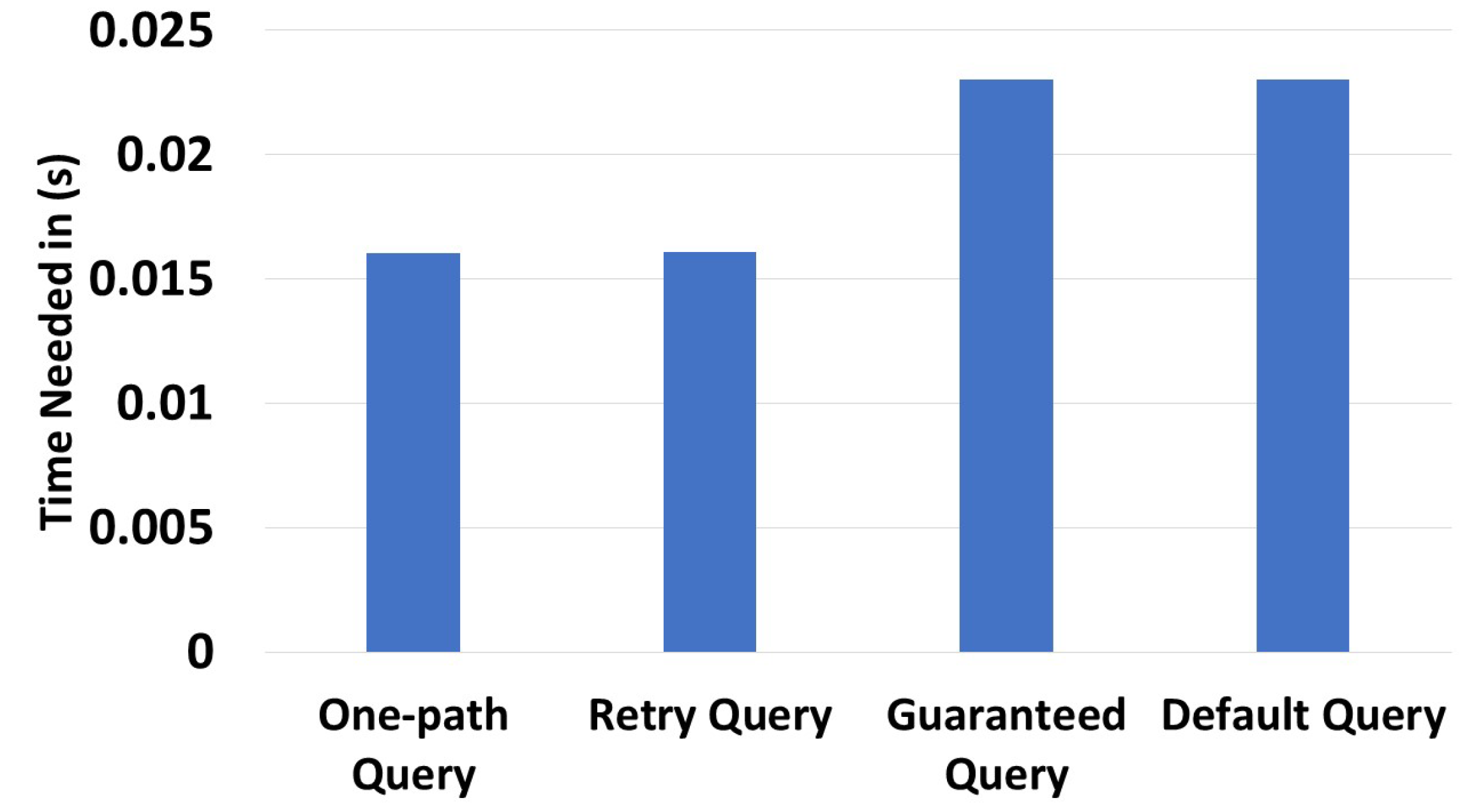
| Device Capacities | Types of Queries | Indexing Coverage | |
|---|---|---|---|
| GHT/DIFS [24,25] | No | One-path | Only Covered zones |
| GH-Indexing [26] | No | One-path | Not explained |
| Mod. DP-means [27] | No | Sequential (One-path) | Only covered zones |
| ECH [28]/EGF-Tree [29] | No | One-path | Only covered zones |
| DSIS [30] | Yes (capacity is the number of sensors for WSN) | Guaranteed (Success/Fail) | Not explained |
| BCCF-Tree [31] | Yes (container) | One-path | Not explained |
| Multi-index [33] | No | One-path | Not explained |
| A-DBSCAN [32] | No | One-path | Only covered zones |
| Our approach | yes | One-path, Retry, Guaranteed | Covered and uncovered zones |
| z2 | z12 | z9 | z10 | z6 | z3 | z5 | z16 | z15 | z13 | z0 | z1 | z4 | z7 | z8 | z11 | z14 | z17 | |
|---|---|---|---|---|---|---|---|---|---|---|---|---|---|---|---|---|---|---|
| d40 | * | 0 | 0 | 0 | 0 | 0 | 0 | 0 | 0 | 0 | 0 | 0 | 0 | 0 | 0 | 0 | 0 | 0 |
| d11 | 0 | * | 0 | 0 | 0 | 0 | 0 | 0 | 0 | 0 | 0 | 0 | 0 | 0 | 0 | 0 | 0 | 0 |
| d28 | 0 | 0 | * | 0 | 0 | 0 | 0 | 0 | 0 | 0 | 0 | 0 | 0 | 0 | 0 | 0 | 0 | 0 |
| d34 | 0 | 0 | 0 | * | 0 | 0 | 0 | 0 | 0 | 0 | 0 | 0 | 0 | 0 | 0 | 0 | 0 | 0 |
| d13 | 0 | * | 1 | 0 | 0 | 0 | 0 | 0 | 0 | 0 | 0 | 0 | 0 | 0 | 0 | 0 | 0 | 0 |
| d8 | 0 | 0 | 0 | 0 | * | 1 | 0 | 0 | 0 | 0 | 0 | 0 | 0 | 0 | 0 | 0 | 0 | 0 |
| d29 | 0 | 0 | * | 1 | 0 | 0 | 0 | 0 | 0 | 0 | 1 | 0 | 0 | 0 | 0 | 0 | 0 | 0 |
| d32 | 0 | * | 1 | 0 | 0 | 0 | 0 | 0 | 0 | 0 | 0 | 1 | 0 | 0 | 0 | 0 | 0 | 0 |
| d12 | 0 | * | 1 | 0 | 0 | 0 | 0 | 0 | 0 | 1 | 1 | 0 | 0 | 0 | 0 | 0 | 0 | 0 |
| d30 | 0 | 0 | 0 | * | 1 | 0 | 1 | 0 | 0 | 0 | 0 | 1 | 0 | 0 | 0 | 0 | 0 | 0 |
| d35 | 0 | 0 | * | 1 | 0 | 0 | 0 | 1 | 0 | 0 | 0 | 0 | 1 | 0 | 1 | 0 | 0 | 0 |
| d10 | 0 | 0 | 0 | 0 | 0 | * | 1 | 0 | 1 | 0 | 0 | 0 | 0 | 1 | 0 | 1 | 0 | 0 |
| d15 | 0 | 0 | 0 | * | 1 | 0 | 0 | 0 | 0 | 1 | 0 | 0 | 0 | 0 | 1 | 0 | 1 | 0 |
| d26 | 1 | 0 | 0 | * | 1 | 0 | 0 | 0 | 0 | 0 | 0 | 0 | 0 | 0 | 0 | 1 | 0 | 1 |
| d20 | 1 | * | 1 | 0 | 0 | 1 | 0 | 0 | 0 | 0 | 0 | 0 | 0 | 0 | 0 | 0 | 1 | 0 |
| d24 | 0 | 1 | 0 | * | 1 | 1 | 0 | 0 | 0 | 0 | 0 | 1 | 0 | 0 | 0 | 0 | 0 | 1 |
| d14 | 0 | * | 1 | 0 | 0 | 0 | 1 | 0 | 1 | 0 | 1 | 0 | 1 | 0 | 0 | 0 | 0 | 0 |
| d27 | 0 | 0 | * | 1 | 0 | 0 | 0 | 1 | 0 | 1 | 0 | 1 | 0 | 1 | 0 | 0 | 0 | 0 |
| d23 | 1 | 0 | 0 | * | 1 | 0 | 0 | 0 | 1 | 0 | 0 | 0 | 1 | 0 | 1 | 0 | 0 | 0 |
| d36 | 0 | 0 | 0 | * | 1 | 1 | 0 | 0 | 0 | 1 | 0 | 0 | 0 | 1 | 0 | 1 | 0 | 0 |
| d2 | 1 | 0 | 0 | 0 | 0 | 0 | * | 1 | 1 | 0 | 0 | 0 | 0 | 0 | 1 | 0 | 1 | 0 |
| d6 | 1 | 1 | 0 | 0 | 0 | 0 | 0 | * | 1 | 1 | 0 | 0 | 0 | 0 | 0 | 1 | 0 | 1 |
| d9 | 1 | 1 | 0 | 0 | 0 | * | 1 | 1 | 0 | 0 | 1 | 0 | 0 | 0 | 0 | 0 | 1 | 0 |
| d38 | 0 | * | 1 | 0 | 0 | 1 | 1 | 1 | 0 | 0 | 0 | 1 | 0 | 0 | 0 | 0 | 0 | 1 |
| d21 | 0 | 0 | 1 | * | 1 | 1 | 0 | 0 | 1 | 0 | 1 | 0 | 1 | 1 | 0 | 0 | 0 | 0 |
| d33 | 1 | 1 | 0 | 0 | 0 | 1 | 0 | 0 | * | 1 | 0 | 1 | 0 | 1 | 1 | 0 | 0 | 0 |
| d25 | 0 | 0 | 0 | * | 1 | 1 | 1 | 0 | 1 | 1 | 0 | 0 | 1 | 0 | 1 | 1 | 0 | 0 |
| d37 | 0 | * | 1 | 0 | 1 | 1 | 0 | 1 | 0 | 1 | 0 | 0 | 0 | 1 | 0 | 1 | 1 | 0 |
| d3 | 1 | 1 | 0 | 0 | 0 | 0 | * | 1 | 1 | 1 | 0 | 0 | 0 | 0 | 1 | 1 | 1 | 1 |
| d18 | 0 | 0 | 0 | * | 1 | 1 | 1 | 1 | 1 | 0 | 1 | 0 | 0 | 0 | 1 | 1 | 0 | 1 |
| d4 | 1 | 0 | 0 | * | 1 | 0 | 1 | 1 | 1 | 0 | 1 | 1 | 0 | 0 | 0 | 0 | 1 | 1 |
| d5 | 1 | 1 | 0 | 0 | 0 | 1 | 1 | 1 | 0 | * | 0 | 1 | 1 | 0 | 0 | 0 | 1 | 1 |
| d16 | 1 | 1 | 1 | * | 1 | 0 | 0 | 0 | 1 | 1 | 1 | 1 | 1 | 1 | 0 | 0 | 0 | 0 |
| d1 | 1 | 0 | 1 | 0 | 0 | 1 | * | 1 | 1 | 1 | 1 | 1 | 1 | 1 | 1 | 0 | 0 | 0 |
| d19 | 1 | * | 1 | 0 | 1 | 0 | 1 | 1 | 0 | 1 | 1 | 0 | 1 | 1 | 1 | 1 | 0 | 0 |
| d17 | 0 | 1 | 1 | * | 1 | 1 | 1 | 1 | 1 | 0 | 0 | 0 | 1 | 1 | 1 | 1 | 1 | 0 |
| d31 | 1 | 0 | 1 | * | 1 | 1 | 1 | 0 | 1 | 1 | 0 | 1 | 0 | 1 | 1 | 1 | 1 | 1 |
| d22 | 1 | 1 | 0 | 1 | 1 | 1 | 1 | 1 | 1 | * | 1 | 0 | 1 | 0 | 1 | 1 | 1 | 1 |
| d39 | 1 | 1 | 1 | 1 | 1 | 1 | 1 | 1 | 1 | 1 | 1 | 1 | 1 | 1 | 0 | 1 | 1 | 1 |
| d41 | 1 | 1 | 1 | 1 | 1 | 1 | 1 | 1 | 1 | 1 | 1 | 1 | 1 | 1 | 1 | 1 | 1 | 1 |
| d7 | 1 | 1 | 1 | 1 | 1 | 1 | 1 | 1 | 1 | 1 | 1 | 1 | 1 | 1 | 1 | 1 | 1 | 1 |
Disclaimer/Publisher’s Note: The statements, opinions and data contained in all publications are solely those of the individual author(s) and contributor(s) and not of MDPI and/or the editor(s). MDPI and/or the editor(s) disclaim responsibility for any injury to people or property resulting from any ideas, methods, instructions or products referred to in the content. |
© 2023 by the authors. Licensee MDPI, Basel, Switzerland. This article is an open access article distributed under the terms and conditions of the Creative Commons Attribution (CC BY) license (https://creativecommons.org/licenses/by/4.0/).
Share and Cite
Achkouty, F.; Chbeir, R.; Gallon, L.; Mansour, E.; Corral, A. Resource Indexing and Querying in Large Connected Environments. Future Internet 2024, 16, 15. https://doi.org/10.3390/fi16010015
Achkouty F, Chbeir R, Gallon L, Mansour E, Corral A. Resource Indexing and Querying in Large Connected Environments. Future Internet. 2024; 16(1):15. https://doi.org/10.3390/fi16010015
Chicago/Turabian StyleAchkouty, Fouad, Richard Chbeir, Laurent Gallon, Elio Mansour, and Antonio Corral. 2024. "Resource Indexing and Querying in Large Connected Environments" Future Internet 16, no. 1: 15. https://doi.org/10.3390/fi16010015
APA StyleAchkouty, F., Chbeir, R., Gallon, L., Mansour, E., & Corral, A. (2024). Resource Indexing and Querying in Large Connected Environments. Future Internet, 16(1), 15. https://doi.org/10.3390/fi16010015







